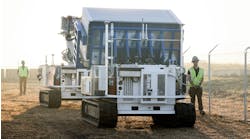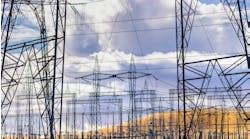HOLSTEIN SOLAR PROJECT
Location: Wingate, Texas
Project Timeline: The project began in July 2019, and Holstein Solar became operational on June 1, 2020.
Number of Photovoltaic Panels: 709,000 solar panels across about 1,300 acres
Energy Production: 200MW AC
Electrical Contractor: The PV field electrical work was self-performed by Blattner Energy, the EPC contractor. Interstate Electrical Contractors, Inc., performed the substation work, and gen-tie transmission line work was performed by Ward Electric Co.
Electrical Engineer: Ulteig Engineers
Owner: Duke Energy Renewables
Texas is one of the fastest growing solar energy markets in the country, says Chris Fallon, president of Duke Energy Renewables. Case in point: Duke Energy Renewables just brought one of its largest solar projects online — the Holstein Solar Project.
“Holstein Solar supports the state’s growth and is a great addition to Duke Energy Renewables, growing Texas solar energy portfolio,” Fallon says. “This project is providing low-cost, clean energy resources to meet the growing needs of Texans.”
Duke Energy Renewables partnered with Blattner Energy for the first time on this solar project. As with most large projects, the key to the successful completion of the project was good planning, sequencing of the work, and timely delivery of materials. By developing and executing the plan, the companies were able to keep the project on schedule.
During the project, Blattner Energy was responsible for the electrical scope of work, which included the wiring of PV modules, bringing the DC power to the inverters, and installation of the inverters and MV AC power to the
collector/project substation, which was built by Interstate.
The electrical scope also included the building of the collector/project substation, performed by Interstate and the installation of 1.5-mile, 345kV transmission line, performed by Ward. Overall, the project employed up to 400 workers during the peak of construction. Building a utility-scale solar project can be compared to assembly line in a field, Fallon says.
According to Duke Energy, the construction of a utility solar project involves many repetitive activities, such as installing 700,000-plus modules. Blattner
Energy employed several techniques for a systematic approach of component installation, such as strategic staging of material and preassembly areas for certain materials.
During construction, the most significant challenge faced by the field crews was dealing with changes implemented to adhere to COVID-19 safety protocols. About two-thirds of the way into construction, new COVID-19 protocols were implemented to ensure the safety of the team. Workers were transported to the site in smaller groups, additional cleaning procedures were implemented, daily meetings were conducted with smaller groups throughout the day, and strategies were frequently evaluated to be able to perform construction activities within COVID-19 safety protocols and sanitation standards.
By following these new safety guidelines, the field team, management, and oversight teams adapted and remained safe, and the Holstein Solar project was brought online on schedule. Now that it is operating, the solar project will use a hedge agreement. Much of the energy generated from the Holstein Solar project will be sold through a 12-year term hedge agreement to J. Aron & Company LLC, a subsidiary of Goldman Sachs.
The Holstein Solar Project is among four Duke Energy Renewables solar generation facilities in Texas. The 100MW AC Lapetus Solar Project in Andrews County went into commercial operation in January 2020 and the 200MW AC Rambler Solar Project in Tom Green County went into commercial operation on June 30, 2020.
The addition of these projects will bring Duke Energy Renewables’ total Texas solar energy portfolio to 514MW AC.




